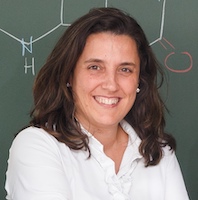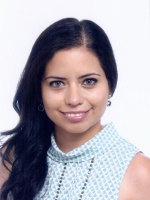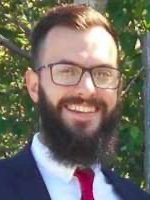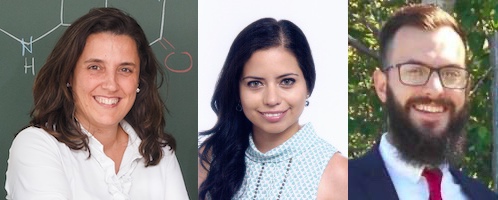Program
13:00 Opening and chair: Trygve Helgaker
13:05 Relativity and Dynamics in Computational NMR Spectroscopy, Abril C. Castro
13:35 Evolutionary Principles of Biocatalysts in Extreme Environments, Ryan Wilkins
14:05 Break
14:15 Almlöf–Gropen Lecture 2020: Light and shadows on the quantum simulation of molecular electronic excited states, Leticia Gonzalez
15:00 Closing: Kenneth Ruud

Almlöf–Gropen Lecturer, Leticia Gonzalez
Institute of Theoretical Chemistry, University of Vienna, Vienna, Austria
Prof. González is head of the Institute of Theoretical Chemistry, Faculty of Chemistry, at the University of Vienna. Born in 1971 in Madrid, she graduated in Chemistry at the Universidad Autónoma de Madrid, Spain, and obtained her PhD in Chemistry in 1998. In 1999 she moved to the Free University Berlin (Germany) as a postdoctoral research and ob- tained her Habilitation and venia legendi in 2004. She was appointed Professor at the Friedrich-Schiller-University of Jena (Germany) in 2007 and full Professor at the University of Vienna (Austria) in 2011. She was Heisenberg Fellow in 2007, received the Dirac Medal from the World Association of Theoretical and Computational Chemists in 2011, has been awarded the Löwdin lecturer in 2014 and a Honoris Causa doctorate by the University of Lorraine in 2018. She is author of more than 250 publications, she has delivered over 180 invited lectures all over the world and serves as a reviewer for numerous international journals and funding agencies.
Abstract: Light and shadows on the quantum simulation of molecular electronic excited states
How do molecules react to light? While light is the driving force behind a number of chemical reactions vital in chemistry, biology and even medicine understanding how molecular properties change upon light irradiation is not an easy task. Quantum theory possesses the fundamental equations to calculate electronically excite states and simulate its time-evolution and yet it is plagued of challenges. In this talk I will review recent progress and strategies developed in my group to disentangle light-induced processes related to systems of different complexity, from gas phase to solution or embedded in biological environments.

Almlöf–Gropen Young Speaker, Abril C. Castro
Hylleraas Centre, University of Oslo, Oslo Norway
Abril obtained her Bachelor (2010) and Master in Science degrees (2012) in Chemistry at the University of Guanajuato, Mexico. In 2013, she was awarded Best Master Thesis in the area of Thermodynamics. In 2018, she obtained a postdoctoral position at the University of Guanajuato, Mexico. In 2019, she joined the Hylleraas Centre as postdoctoral researcher with a prestigious Marie-Curie Individual Fellowship funded by the European Union.
Abstract: Relativity and Dynamics in Computational NMR Spectroscopy
NMR (Nuclear Magnetic Resonance) spectroscopy is among the most important means of characterization for transition-metal complexes. In this regard, the accurate prediction of NMR properties provides a useful but challenging, strategy to help in the interpretation of the spectra. The enormous challenge when modelling NMR spectra of heavy-nuclei molecules, arises from the extreme sensitivity to relativistic and environmental effects. Therefore, sophisticated and more realistic models are needed to mimic the experimental conditions. In this talk, I show the predictive capabilities of a computational protocol combining a relativistic fully four-component method with ab-initio molecular dynamics simulations for treating the relativistic and solvent effects, respectively. Examples of complex systems with diverse types of metal centre, structure environment, and bonding interactions will be discussed.

Almlöf–Gropen Young Speaker, Ryan Wilkins
Hylleraas Centre, UiT The Arctic University of Norway, Tromsø, Norway
Ryan is a Ph.D. student within the CUBE3 project at the UiT The Arctic University of Norway. He comes from Canada, where he finished his B.Sc. in Physics at Memorial University of Newfoundland and his M.Sc. in Biophysics at the University of Guelph. His background is in the development and implementation of statistical mechanics methodologies in biophysical simulations, which he is utilising to work towards a better understanding the mechanisms by which homologous enzymes are able to adapt to a wide range of environments.
Abstract: Evolutionary Principles of Biocatalysts in Extreme Environments
Understanding the roles activation enthalpies and entropies play in enzyme catalysis plays a key role in understanding the function of enzymes. In chorismate mutase enzymes, a common model system used in benchmarking computational chemistry tools, the degree to which the activation enthalpy and entropy play a role in the conversion of chorismate to prephenate has been subject to debate. Herein, we use EVB/MD free energy calculations, along with the computational Arrhenius plot method, to extract the activation enthalpy and entropy of this enzyme-catalyzed reaction. Our results demonstrate that in comparison to the conversion of chorismate to prephenate in water, the enzyme-catalyzed reactions occurring within BsCM and PchB show a large reduction in activation enthalpies, while the reduction of activation entropies is relatively small. This provides evidence that the enzyme-catalyzed reactions in BsCM and PchB are enthalpically driven in nature. Furthermore, from a structural analysis of the reaction during the transition state, we were able to identify key residues which may help explain the observed reduction in enthalpy for the reaction, and also why BsCM appears to be more efficient than PchB in catalyzing this reaction.
